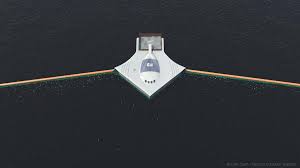A young prodigy has kickstarted a campaign to clean up the world’s oceans, which have become polluted by rubbish and debris over the year.
Incensed by the unsustainable dumping of rubbish in the oceans, Boyan Slat, 19, came up with an idea to build a device to pull rubbish from the oceans.
Every year, millions of tons of garbage gets dumped into the oceans and repeat incidence of oil spills like the Deepwater Horizon Disaster are an ongoing problem.
Add that to the fact that almost 100,000 marine animals are killed due to debris entanglement and continually rising pollution every year.
Much of the oxygen we breathe on the planet comes from the marine phytoplankton, more than from all the forests on the earth. In short, if the oceans suffer, we do.
But Slat believes he has the solution to clean up the problem. His idea consists of an anchored network of floating booms and processing platforms that could be dispatched to garbage patches around the world. Working with the flow of nature, his solution to the problematic shifting of trash is to have the array span the radius of a garbage patch, acting as a giant funnel as the ocean moves through it.
He is the creator of the Ocean Array Plan, a project that could remove 7,250,000 tons of plastic from the world’s oceans in just five years.
He argues that the angle of the booms would force plastic in the direction of the platforms, where it would be separated from smaller forms, such as plankton, and be filtered and stored for recycling. The issue of by-catches, killing life forms in the procedure of cleaning trash, can be virtually eliminated by using booms instead of nets and it will result in a larger areas covered.
Because of the density of trash compared to sea animals, the use of booms will allow creatures to swim under the booms unaffected, reducing wildlife death substantially.
He added that the project could sustain itself, because the platforms would be completely self-supportive and receive their energy from the sun, currents, and waves.
By also letting the platforms’ wings sway like an actual manta ray, contact with inlets in the roughest weather can be ensured. It’s a plan that merges environmental safety with thoroughly thought out processes.
On his website, boyanslat.com, Boyan stated: “”It will be very hard to convince everyone in the world to handle their plastics responsibly, but what we humans are very good in is inventing technical solutions to our problems. And that’s what we’re doing.””
Slat initially came up with the idea after launching a project at school that analyzed the size and amount of plastic particles in the ocean’s garbage patches; his final paper went on to win several prizes, including Best Technical Design 2012 at the Delft University of Technology.
He then founded the The Ocean Cleanup Foundation, a non-profit organization responsible for the development of proposed technologies.
In addition to the environmental benefits, he argued that his plan could save millions of pounds a year due to clean-up costs, lost tourism, and damage to marine vessels.
Not only that, although extensive feasibility studies are currently being conducted, it has been estimated that the project could potentially be profitable, because through the selling of plastic retrieved over the five years, the money would then surpass the initial cost to execute it.
It is estimated that the project could take five years to complete, but the development of greater environmental awareness would arise in the meantime.
















Follow Us!